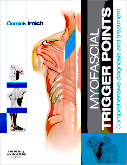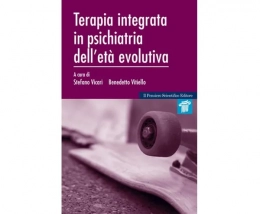Non ci sono recensioni
| Description | |
|
Pain and limited function of the locomotor system are the most common reasons for visiting a doctor or therapist. Muscles play a key part in these presentations as a result of their function and anatomy with current research suggesting that muscle imbalance, muscle tension and painful functional disorders are at the forefront when it comes to acute or chronic symptoms. The clinical correlate with all such symptoms is the myofascial trigger point. Myofascial Trigger Points: Comprehensive Diagnosis and Treatment examines all aspects of muscle physiology and the pathogenesis of myofascial pain. The book provides valuable advice on diagnosis and differential diagnosis and contains detailed, practice-oriented information and numerous illustrations of the various therapeutic procedures for the treatment of myofascial trigger points. Prepared by experts from throughout the world, Myofascial Trigger Points: Comprehensive Diagnosis and Treatment will be ideal for all manual therapists, physiotherapists, osteopathic physicians, osteopaths, chiropractors, acupuncturists, massage therapists and naturopaths. |
| Author Info | |
| By Dominik Irnich, MD, Head of the Multidisciplinary Pain Centre, Department of Anesthesiology, University of Munich, Germany |
Table of Contents:
Section 1 The background
1 Guide to the book
2 Terminology
3 Epidemiology
3.1 Etiology of disease
3.2 Epidemiology
4 Etiology of myofascial pain syndrome
4.1 Causative factors
4.2 Perpetuating factors of myofascial pain
4.3 Chronification of myofascial pain
5 The anatomy and physiology of the muscles
5.1 Macroscopic construction
5.2 Function
5.3 Neurophysiology
6 Pathophysiology
6.1 Historical development
6.2 Underlying theories of pathophysiology
6.3 Specific pathophysiology
6.4 The extended integrated hypothesis
7 The trigger point as expression of a functional disorder of the locomotor system
7.1 The function of the locomotor system in association with memory
7.2 Pathophysiological role of mTrP
8 Trigger points and myofascial pain - acupuncture points and meridian system
8.1 Trigger points and acupuncture points
8.2 Referred pain and meridians
8.3 Other study results
8.4 Pain and somatovisceral correspondence of trigger and acupuncture points
8.5 Summary
9 Myofascial trigger points and fascia
9.1 Anatomy - definitions
9.2 Biomechanical function
9.3 Muscle hardening (taut bands)
9.4 Fascia as sensory organ
9.5 Association with trigger points - therapeutic considerations
10 Fibromyalgia syndrome
11 Myofascial trigger points and somatoform pain
11.1 Introduction and clinical information
11.2 Epidemiology
11.3 Etiology and pathogenesis
11.4 Differential diagnosis
11.5 Therapy
11.6 Health service assessment
12 Integrated holistic consideration of the muscles
12.1 Introduction
12.2 Function and purpose of the muscles
12.3 Approach via acupuncture
13 Diagnosis of myofascial pain
13.1 Principles
13.2 Questioning
13.3 Physical examination
13.4 Specific diagnosis of myofascial trigger points
13.5 Technical test procedures
13.6 Creating a comprehensive diagnosis with instructions for treatment
14 Differential diagnosis
14.1 Differential diagnosis according to affected structure and cause
14.2 Differential diagnosis depending on distribution pattern
Section 2 Treatment of myofascial pain
15 Principles of treatment
15.1 Doctor-patient relationship
15.2 Practical hints
15.3 Legal aspects
15.4 Documentation of progress
16 Peculiarities of doctor-patient relationship with chronic pain
17 Selection of suitable treatments
17.1 Standard treatments
17.2 Other (traditional) treatments
18 Manual therapies and physiotherapeutic procedures
18.1 Dejung manual trigger point therapy
18.2 Lewit treatment techniques
18.3 Spray and stretch, cool and extend
18.4 Fascia techniques for the treatment of mTrP
19 Treatment concept - myofascial trigger point therapy
19.1 Manual techniques and dry needling
19.2 Extension, relaxation/stretching, detensioning
19.3 Functional training, ergonomics
20 Physical procedures
20.1 Ultrasound therapy
20.2 Hot and cold treatments
20.3 Electrotherapy
20.4 Cupping
20.5 Transcutaneous electrical nerve stimulation
20.6 Laser therapy
20.7 Shock wave therapy
21 Trigger point infiltration
21.1 Indications and contraindications
21.2 Injectants
21.3 Technique
22 Acupuncture and related procedures
22.1 Dry needling (trigger point acupuncture)
22.2 Classical acupuncture
22.3 Kiiko Matsumoto acupuncture
22.4 Microsystem acupunture
22.5 Electrostimulation acupuncture
22.6 Laser acupuncture
22.7 Preusser gelopuncture
22.8 Tuina
23 Complementary and alternative therapy methods and naturopathic treatments
23.1 Definitions
23.2 Basic principles
23.3 Treatment procedures
23.4 Integration of complementary and alternative methods in multimodal pain programme
24 Relaxation techniques - body and mind
24.1 Preliminary remarks
24.2 Western relaxation techniques
24.3 Eastern relaxation techniques
25 Systemic pharmacotherapy
25.1 Introduction
25.2 Substance groups
25.3 Treatment strategy
Section 3 Muscles and trigger points
26 Head
26.1 M. masseter
26.2 M. temporalis
26.3 M. pterygoideus medialis
26.4 M. pterygoideus lateralis
26.5 M. digastricus
26.6 M. stylohyoideus
26.7 M. mylohyoideus
26.8 M. geniohyoideus
27 Throat, neck and shoulder region
27.1 M. splenius capitis
27.2 M. splenius cervicis
27.3 Muscles of the cervical M. erector trunci
27.4 Suboccipital muscles
27.5 M. sternocleidomastoideus
27.6 Mm. scaleni
27.7 M. trapezius
27.8 M. levator scapulae
28 Shoulder and upper arm
28.1 M. deltoideus
28.2 M. supraspinatus
28.3 M. infraspinatus
28.4 M. teres minor
28.5 M. latissimus dorsi
28.6 M. teres major
28.7 M. subscapularis
28.8 Mm. rhomboidei major and minor
28.9 M. coracobrachialis
28.10 M. biceps brachii
28.11 M. brachialis
28.12 M. triceps brachii (with M. anconaeus)
29 Elbow, forearm and hand
29.1 Hand extensors
29.2 M. brachioradialis
29.3 Finger extensors
29.4 M. supinator
29.5 M. palmaris longus
29.6 Hand and finger flexors in the forearm
29.7 M. adductor et opponens pollicis
30 Thoracic spine and thorax
30.1 Thoracic autochtonous back extensors
30.2 M. pectoralis major
30.3 M. pectoralis minor
30.4 M. sternalis
30.5 M. serratus posterior superior
30.6 M. serratus anterior
30.7 M. serratus posterior inferior
31 Abdomen
31.1 M. rectus abdominis
31.2 M. obliquus abdominis (externus et internus)
31.3 M. pyramidalis
32 Lumbar spine, pelvis and hip region (pelvic girdle)
32.1 Lumbar autochthonous back muscles
32.2 M. quadratus lumborum
32.3 M. iliopsoas major
32.4 Pelvic floor muscles
32.5 M. gluteus maximus
32.6 M. gluteus medius
32.7 M. gluteus minimus
32.8 M. piriformis
33 Hip, thigh and knee
33.1 M. tensor fasciae latae
33.2 Adductors of the hip joint.
33.3 M. quadriceps femoris
33.4 Ischiocrural muscles
33.5 M. popliteus
34 Lower leg and foot
34.1 M. tibialis anterior
34.2 Mm. peronei (fibulares) longus et brevis
34.3 M. gastrocnemius
34.4 M. soleus
34.5 M. tibialis posterior
34.6 M. extensor hallucis longus and extensor digitorum longus
34.7 M. flexor digitorum longus and flexor hallucis longus




